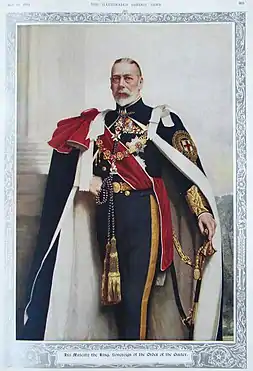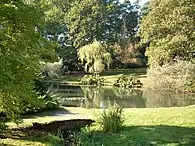Silver Jubilee of George V
The Silver Jubilee of George V on 6 May 1935 marked 25 years of King George V as the King of the United Kingdom and the British Dominions, and Emperor of India.[1] The Jubilee was marked with large-scale and popular events throughout London and the rest of the United Kingdom in May 1935. It was the first ever Silver Jubilee celebration of any British monarch in history.[2] The king died less than a year later.

Celebrations
The Silver Jubilee Celebrations in London began with a carriage procession through London to St Paul’s Cathedral for a Thanksgiving Service on 6 May 1935. It was followed by another procession back to Buckingham Palace, where the Royal Family appeared on the balcony. The King and Queen were joined by members of the Royal Family, including Queen Maud of Norway, the Prince of Wales, the Duke and Duchess of York, Princess Mary and the Earl of Harewood, the Duke and Duchess of Kent, and the Duke of Gloucester. Due to popular demand, the King waved from the same balcony for a few consecutive days later in the same week.[3][4]
The Jubilee day was declared a bank holiday[5] and celebrations were held across the United Kingdom with garden parties, pageants and sports events.[6] At 8 pm, the King's Jubilee speech was transmitted. He gave thanks ‘from the depths of his heart to his dear people’ on behalf of himself and Queen Mary, for the Jubilee commemorations.[7]
Throughout the month of May, The King continued taking carriage rides through London. He also took one through north London for the Queen's birthday on 26 May, during which they were accompanied by their two granddaughters: Princesses Elizabeth and Margaret.[3]
The Jubilee was also marked with a ball for two thousand guests at Buckingham Palace on May 14, an Empire Exhibition and the State Opening of Parliament. A reception was hosted by the Lord Mayor of London in honour of the King and Queen, which was also attended by the Prince of Wales and the Duke and Duchess of York.[4]
During the Jubilee celebrations, the King received a large number of telegrams from across the empire and around the world, with warm wishes, both from world leaders and his subjects. The public’s reaction to George V’s appearances over the jubilant celebrations only confirmed the popularity of a Jubilee celebration as well as the esteem in which the King was held.[1][7]
Commemorative
A Silver Jubilee Medal was created to a commemorate the Jubilee. It was awarded to the members of the Royal Family and selected officers of state, officials and servants of the Royal Household, ministers, government officials, mayors, public servants, local government officials, members of the navy, army, air force and police in Britain, her colonies and Dominions.[8]
The Jubilee was marked by loads of different Jubilee souvenirs. Every child born on the Jubilee Day (6 May 1935) was given a special silver commemorative cup.[9] A Silver crown coin was also released by The Royal Mint to mark the Jubilee.[5][10] Specific sets of stamps were issued for the Jubilee in the United Kingdom and the dominions, including issues in Australia, Canada, India, New Zealand and South Africa.[11][12]
See also
- Royal Address to the Nation
- List of monarchs in Britain by length of reign
- List of Jubilees of British monarchs
References
- Harold Nicolson, King George V (1953) pp 510–532. online
- "No silver jubilee for Queen Victoria". The Guardian. 14 September 2015.
- "1935 - George V, Silver; St Paul's Cathedral". stpauls.co.uk.
- "King George V's Silver Jubilee, 1935". The Royal Watcher. 6 May 2020.
- "King George V's Silver Jubilee". Wokingham Virtual Museum.
- "The Silver Jubilee of King George V and Queen Mary 1935". Brockham History.
- Owens, Edward (15 October 2018). The Family Firm: Monarchy, Mass Media and the British Public, 1932-53. University of London Press. p. 420. ISBN 9781909646988.
- Howard N Cole. Coronation and Royal Commemorative Medals. p. 40. Published J. B. Hayward & Son, London. 1977.
- "George V Silver Jubilee Cup". BBC.
- "George V Silver Jubilee crown". Google Arts & Culture.
- "Silver Jubilee". The Postal Museum.
- "A history of Jubilees | The Royal Family". Royal.uk.


.jpg.webp)
_(cropped).jpg.webp)